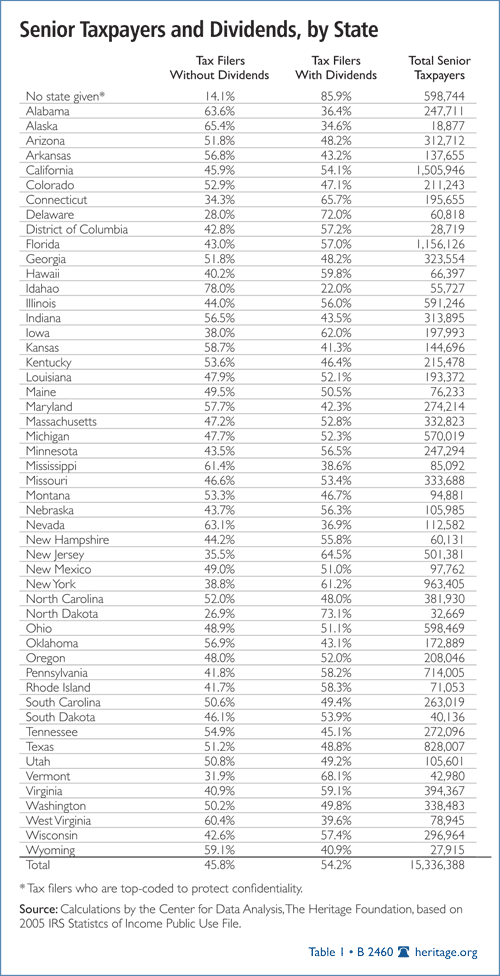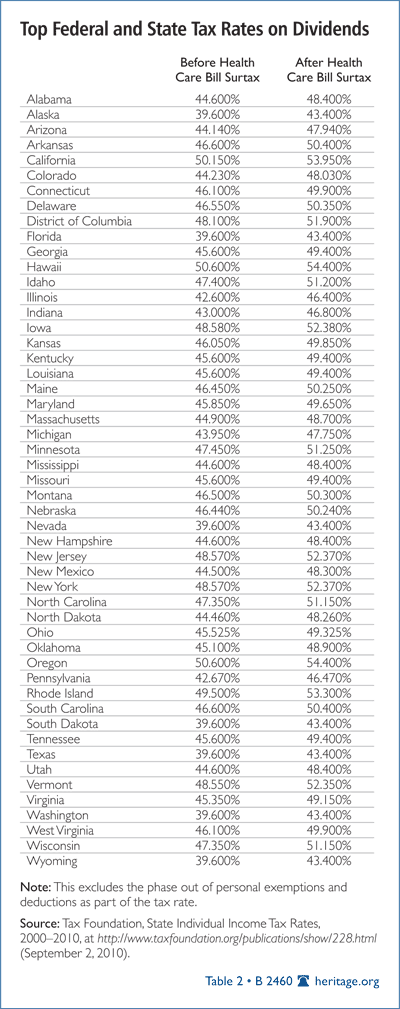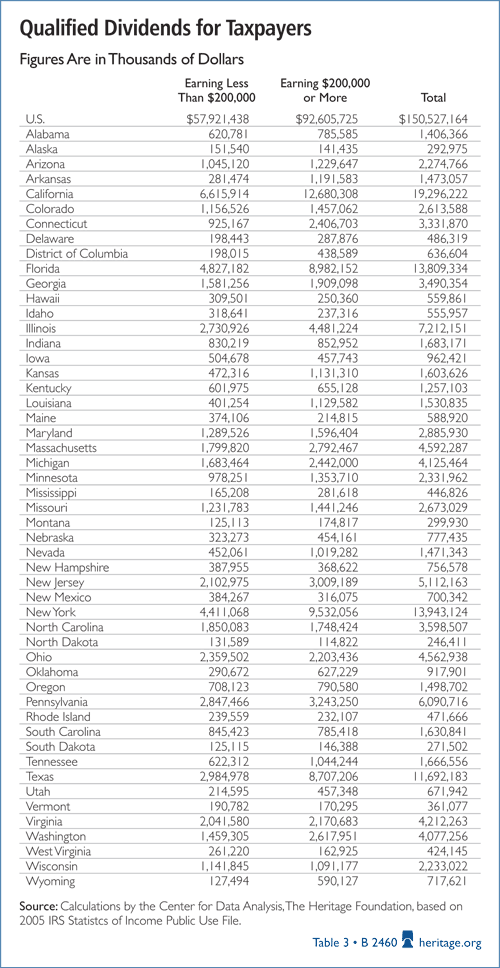Abstract: The top tax rates on qualified dividends are scheduled to jump from 15 percent to nearly 40 percent on January 1, 2011—just one of many reasons the Bush tax relief should be extended. Without an extension, dividend payments will be taxed at a far higher rate than capital gains, distorting how companies return value to their shareholders—penalizing companies that pay out dividends. Dividend-paying stocks are owned disproportionately by seniors, which means that many retirees will have to live on smaller incomes. American companies also suffer under an antiquated U.S. tax code—which taxes companies that earn profits overseas and have already paid taxes in their country of domicile. The Heritage Foundation explains why a dividend tax hike simply has no benefit for Americans on any level—and will likely cause much harm.
With President Obama’s tax hikes scheduled to start at the end of this year, the top tax rates on qualified dividends will almost triple from 15 percent to 39.6 percent on January 1, 2011. Dividend payments will be taxed at a much higher rate than capital gains, which will create distortions of how companies return value to shareholders. This tax policy favors capital gains distributions and penalizes companies that return value to shareholders through dividends.
Evidence from the 2003 tax cut and the 1993 tax hikes shows that companies are responsive to changes in tax rates. In 2003, companies increased dividend payments when the tax on dividends declined. In 1993, however, the top marginal tax rates increased and the long-term trend of declining dividend payments continued.[1]
A higher tax rate on dividend income will affect more than just decisions of companies. Senior citizens disproportionately hold dividend-paying stocks, with almost half of all tax filers ages 65 or older reporting dividend income. These seniors will have lower incomes and consume less due to lower payouts.
Congress should extend the tax relief to maintain a low tax rate on dividends in order to maximize economic growth, prevent inequities in the tax code, and not penalize seniors.
Horizontal Equity and Dividends
The principle of horizontal equity is central to U.S. tax policy and assures that individuals with the same or equal incomes should pay equal taxes. Applying the principle in this case means that investors should pay the same tax rate on any investment income. After the 2003 tax cuts, investors do, indeed, pay the exact same federal tax rate on income from long-term capital gains and qualified dividends. However, the impending tax hikes will favor investors who receive capital gains income over dividends, thus violating this key tax principle.
The Internal Revenue Service defines dividends as transfers of property from a corporation to its stockholders. The transfer of property can be in the form of money, its own or another corporation’s stock, or other property. Corporations sometimes pay regular quarterly dividends. In addition or instead, a corporation might make a one-time payment called a special dividend of cash, stock, or other property to its stockholders.
Ordinary dividends are paid out of the earnings and profits of a corporation and are cash payments to stockholders. Ordinary dividends are taxable at a recipient’s ordinary income tax rate unless they are qualified dividends. In order to count as a qualified dividend, the dividend paying corporation stock must be owned for 61 days or more during the 121-day period that starts 60 days before the ex-dividend date. The ex-dividend date is the first date that a person who buys a stock is not entitled to an upcoming dividend.
With the tax hikes, the tax rate on capital gains taxes increases from 15 percent to 20 percent in 2011 and then to 23.8 percent in 2013. The impact on dividends is much greater: The rate jumps from 15 percent to a top rate of 39.6 percent in 2011 and then to 43.4 percent in 2013, because qualified dividends will no longer be taxed like capital gains. Capital gains will be taxed at 55 percent of the tax rate of dividends.
Capital gains will be “advantaged” by the tax code after these tax rate changes, and businesses are more likely to focus on stock appreciation as the best way to return shareholder value instead of paying dividends. This is bad news for stockholders. Like capital gains, dividend payments can provide stockholders valuable information on how the company underlying their investment is performing. When a firm fails to pay a dividend or provides key information in the course of paying dividends, investors learn better how the company is performing than by just reading company press releases.
One of the reasons that the dividend tax cut was so popular in 2003 was that fewer firms retained their earnings, which often allows a company to hide its true financial condition. Indeed, the 2003 tax rate reduction occurred just after a number of major companies had dramatically misled investors in order to boost their stock values. Investors wanted more transparency about companies. Dividends are a signal of sustainable income and thus seen as a signal of the firm’s quality.[2] The announcements of dividend increases usually have the added benefit of generating a higher stock price for firms, which spurs future investment and production in that company.[3] While equal tax treatment will not fix corruption, it will allow investors to choose firms that offer steady payouts instead of the volatility of stock price changes.
The Revenue Reconciliation Act of 1993 and the Tax Hike on Dividends
The Revenue Reconciliation Act of 1993 raised the top tax rate on dividends to 39.6 percent (from 31 percent) by changing the income tax rates. Dividend payments were worth less to affected taxpayers after the tax increase. However, the top rate on capital gains remained at 28 percent and increased in value compared to dividend payouts.
The tax increase lowered the value of firms and raised the cost of capital for dividend-paying firms. In addition, the disparity between tax rates created inefficiency in the stock market, causing it to provide misleading information to savers and investors.
Economic studies have shown that a rise in dividend tax rates lowers the share prices of dividend-yielding stocks. Several studies suggest that “dividend taxes are largely capitalized into share prices.”[4] A dividend becomes less valuable when more of it is taxed, so tax-paying investors only buy the stocks at lower prices, since they are getting less of a yield in dividends from the investment. A rise in the dividend tax rates above capital gains tax rates injects a preference for stock holdings that only carry capital gains rather than yielding dividends. This causes high-dividend-yielding stocks to appear less worthy of investors’ money than identical stocks of companies that plow the would-be dividend yields back into share repurchases, or investments in the company. Research has shown that when the Revenue Reconciliation Act raised the tax rate on dividends, higher-dividend-yielding stocks performed worse as a result than lower-dividend-yielding stocks.[5] Thus, the valuation of the companies changed purely for tax reasons.
This drop in the relative share price of high-dividend-yielding stocks gave an advantage to tax-exempt institutions, such as pension funds, that could then scoop up the high-dividend-yielding stocks at lower prices and earn a higher tax-free dividend yield.[6]
Another consequence of dividend tax rates that are higher than capital gains tax rates is that more people sell stocks leading up to the ex-dividend date, the date when a stock generally drops due to a dividend payout. Investors sell before the drop to avoid paying taxes that they would have to pay if they collected the dividend. This form of trading for tax purposes was found to increase due to the Revenue Reconciliation Act.[7] The tax-induced trading around ex-dividend dates adds noise and confusion into the markets. It is preferable for the markets to behave more fluidly and orderly than to have perfectly good companies shrink in size due to tax-related stock selling, not because of any fundamental flaw in the companies.
One way the Revenue Reconciliation Act stopped some companies from achieving growth is that it compelled companies to increase the value of their dividends. This increase in dividends occurred when a dividend-paying corporation needed to ensure that investors would continue to receive the same total income net of taxes. The pressure to pay part or all of the increase in dividend taxes for the stockholder was greater for companies that are attractive as investments mostly for their high-dividend yield. These are generally slow growth, fully mature companies that employ many people. Paying higher dividends than they would normally pay takes money from the older established corporations that they could otherwise invest in capital assets and labor, both of which provide jobs and contribute to economic growth.
The 19.6 percentage point disparity between the tax rate on dividends and that on capital gains that will occur when the Bush tax cuts expire will dwarf the disparity caused by the Revenue Reconciliation Act—which resulted in an 11.6 percentage point disparity. Thus, the adverse consequences for anyone who owns stocks or mutual funds, and for companies with stocks listed on exchanges, will be amplified. The lessons from the long history of dividend tax rate changes, including those from the Revenue Reconciliation Act, go unheeded at the peril of the U.S. economy.
Effects of the 2003 Dividend Tax Cuts
The Jobs and Growth Tax Relief Reconciliation Act of 2003 (JGTRRA) temporarily cut the top personal tax rate on dividends from 39.6 percent to 15 percent.[8] Firms responded both by initiating and increasing dividend payouts. Not only did dividend payments increase because of a lower tax rate, the bill also had the added effect of promoting a more efficient distribution of investment across firms. However, the potential benefits of this legislation were not fully realized because the tax relief was only temporary.
In the six months following the passage of this legislation, businesses responded aggressively by increasing dividend payouts by $3.8 billion.[9] Moreover, aggregate dividend payouts increased by 30 percent over the following two years.[10] Along with total payouts, the number of firms that initiated regular and special dividends after the tax cut increased as well. Microsoft paid out more than $32 billion in special dividends to its shareholders in the second half of 2004 alone, and then instituted regular dividend payments after years of relying on stock appreciation to return shareholder value. In the two quarters following enactment of JGTRRA, there was an 8 percent increase in dividend initiations from the two quarters before.[11] In fact, the number of dividend initiations in the three quarters immediately following enactment of JGTRRA was the highest of the previous 80 quarters.[12] This is evidence that dividend and capital gains tax rates have a strong effect on the payout policy a firm chooses.
Economists believe that permanent tax cuts generate more economic growth than temporary tax cuts. Both Milton Friedman’s permanent-income theory and Franco Modigliani’s life-cycle theory argue that temporary increases in income due to temporary tax cuts fail to increase consumption because the cuts are not permanent.[13] The same holds true for dividend payouts. Firms are less likely to initiate dividend payouts if there is a chance that they will have to decrease or terminate them in the future due to higher taxes. This is because markets, and therefore the share price of a company, are known to respond negatively to dividend cuts.[14]
Not only were the JGTRRA tax rate reductions slated to last just until 2011, but Senator John Kerry promised to immediately rescind them for the top two tax brackets if he won the presidency in 2004.[15] This of course introduced even greater uncertainty into the market, which dampened the potential benefits of the dividend tax cut. For instance, companies could institute one-time payouts of dividends instead of annual dividend payments.
Impact on Seniors
All holders of dividend-paying stocks will be affected if Congress increases the top marginal tax dividend tax rate to 39.6 percent. Just as in 1993, companies will reduce their dividend payouts. Retirees who rely on dividend income from stocks will see their annual income decline. Conversely, other investors will not be affected as much, as companies will prefer to return value through stock appreciation or a greater appetite for corporate debt-financing.
Seniors are far more likely to own stocks that pay dividends than other demographic groups.[16] (See Table 1.) For tax year 2010, seniors are almost twice as likely to report dividend income on their tax returns.[17] Low-income households are also more likely to own dividend-paying stocks than high-income households. Both these groups want cash income because they have a shorter investment time horizon than other households and need dividend income for immediate consumption. These groups will also have smaller marginal tax rates and are less concerned about the impact of taxes.[18] These are the groups that will be most penalized by increases in the dividend tax rate.

State Taxes in Addition to Federal Taxes
The tax rate on U.S.-based dividend payouts will be among the highest in the world when the federal and state tax rates on dividend income are combined. Individuals will see their potential income gains taxed once at the corporate level, a second time at the federal level, and, finally, at the state level.[19] State taxes increase the marginal tax rate by up to 10 percent, putting the individual marginal top tax rate above 53 percent. An estimate from the Tax Foundation finds that the top effective dividend tax rate will be 68 percent—compared to a world average of 44 percent.[20]
Table 2 shows the distribution of dividends at the state level—over one quarter of all qualified dividends will be taxed above 50 percent in 2013.[21]

Worldwide Taxation and Its Impact on U.S. Firms
Dividend taxes are also affected by the United States’ antiquated system of taxing business income worldwide. The United States currently taxes all U.S. firms on profits earned both inside the country and outside the country. This means that American firms often face double taxation: once by the country in which they are operating, and the second by the U.S. Most other countries only tax corporations on profits earned within their borders. In addition to double taxation, the United States has the second-highest corporate tax rate in the developed world.[22]

The territorial system of taxation, where a company only has to pay taxes on profits earned inside the country in which the company is domiciled, is simpler than America’s “inefficient, complicated, and expensive” international tax code; and because it is simpler, compliance is cheaper.[23] A survey of Fortune 500 companies found that the costs incurred to comply with international tax laws represented nearly 44 percent of their overall tax compliance costs, while “only 27.8 percent of its assets, 30.1 percent of its sales, and 26.2 percent of its employment were generated abroad.”[24] If the tax code is such a hassle for even large corporations operating overseas, one can only imagine the headache that small and mid-size companies face when dealing with international taxes. A tax system that treats all companies equally no matter where they are located has many benefits, and will place a smaller burden on U.S. firms. In fact, research shows that approximately one-fifth of U.S. capital abroad would be in a different location if the U.S. had a more neutral tax policy.[25] These distortions caused by tax policy weaken companies and make them less efficient.
International corporate tax policy is important not only because of its impact on firm competitiveness and capital allocation, but also because of its effect on dividend-payout policies. The corporate tax rate influences dividend-payout rates by foreign subsidiaries to their U.S. parent companies. Research shows that “a one percent decrease in the repatriation tax is associated with a four percent increase in dividend payout rates.”[26]
Conclusion
With the dividend taxes scheduled to rise in 2011, a major distortion in the federal tax code will return. The top marginal rate on dividends will again be almost twice the tax rate of capital gains. The tax code will encourage companies to prefer capital gains distributions over dividends. This will be especially harmful to taxpayers, like seniors, that rely on dividend payments.
Higher taxes on dividends will also harm American companies that are competing in the global marketplace. If America wants to solidify its position as the leader of the world economy, it must strive for tax policies that support growth, not those that undermine a firm’s ability to compete. Congress should extend the tax relief so that dividends and capital gains can be taxed at the same rate.
—Rea S. Hederman, Jr., is Assistant Director of and Research Fellow in, and Patrick Tyrrell is Research Coordinator in, the Center for Data Analysis at The Heritage Foundation. The authors gratefully acknowledge the work and assistance of Alexi Himarios.


